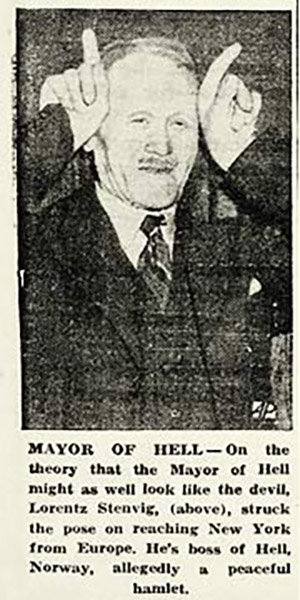Lorentz Stenvig
visiting New York
Lieutenant Lorentz Stenvig (1884–1967) vas a farmer (cattle and grain) in Lånke and as a part time job, supervisor of some military installations (Tønsåsen Batteri). During the German invasion of Norway in April 1940 he participated in the defense of the Hegra fortress and received a medal after the war. In the period 1929–1940 he was elected chairman of the Lånke district assembly. Lånke is a district south of the Stjørdal River with 1465 inhabitants in 1938. Hell is a village and train station in Lånke. In the newspaper article clipping below Lånke is called Hell. Also, the postal address to a major fraction of the Lånke people is 7517 Hell. Now the former administrative district Lånke is incorporated in Stjørdal, which earlier occupied an area only north of the Stjørdal River.

October 16, 1937 Stenvig received this telegram from Robert L. Ripley, host of the "Believe It or Not" NBC radio show running from 1930 till 1948 (the wording might not be quite exact):
– Lieutenant L. Stenvig. Chairman Country Assembly Hell. Can you come to America at once to speak on radio as representative of Hell round trip steamship fare and all expenses will be paid cable reply believe it or not Ripley –
Tuesday, April 5, 1938 Lorentz Stenvig embarked on the liner "Stanvangerfjord", bound for New York. As deduced from the article below he disembarked in New York Friday, April 15.
Stenvig returned to Norway, disembarking May 19, 1938. The postmark shows that the letter depicted on the Hell page was mailed May 30, 1938.
A greeting card from Robert Leroy Ripley 1938
(Trøndelag Folkemuseum)

|

|
Lieutenant Lorentz Stenvigby courtesy of the Lånke Historical Society |

Friday April 22, 1938 |

Saturday, April 16, 1938


Monday, April 25, 1938
An hour's train ride from Trondheim, in central Norway, is Hell, a tiny hamlet (pop. 1,465) which thrives on U.S. excursionists who have fun sending home Hell-marked postcards. Situated on hilly ground, Hell (the Norwegian word for luck or slope) maintains two churches but no fire department, has cool summers, bitterly cold winters, sometimes freezes over completely. Last week mild-mannered, blue-eyed Lorentz Stenvig, mayor of Hell, arrived in Manhattan as the guest of publicity-wise Robert ("Believe It or Not") Ripley, gave the press a chance to make free use of naughty expressions. Sample: chided by Host Ripley for bringing Manhattan a heat wave, Mayor Stenvig replied: "Why, it's hotter than Hell in New York."
[manual copy]
Comments
We should note that the knowledge of English among the great majority of Norwegians was rather poor at that time. If Stenvig really knew the meaning of "mayor" we'll never know. For a Norwegian it's easily confused with "major", which in this language has only one meaning: army (and now also air force) major. Maybe he did know, and accepted "the Mayor of Hell" as good publicity, not only for Robert L. Ripley. After Stenvig's return from New York he was jokingly called, translated, "the major from Hell". This sounds as a "promotion" (from lieutenant) and was either an intended or genuine misinterpretation.
The facts given by New York papers seem quite accurate. They can hardly be blamed for this "Mayor of Hell" stuff, and the false explanation of the origin of the name 'Hell' was probably given by Stenvig. As explained on the Hell page, it derives from Old Norse 'hellir', an overhanging cliff or a shallow cave suited as shelter from rain or snow, of which there are three in the area.
The 1933 movie
This is a different Hell, and contrary to Stenvig's Hell it's rather gloomy.

The Warner Brothers movie "The Mayor of Hell" had it's premiere June 23, 1933. Thus in 1938 the concept of "the Mayor of Hell" was widely known, so when Belive It Or Not Robert Leroy Ripley learned of a real "Mayor of Hell" in Norway, it inevitably triggered a reaction.
In 1933 Warner Brothers used the Vitaphone sound system; special phonograph discs mechanically synchronized to the film projector. Most likely they would also use the dangerously inflammable celluloid film; cellulose acetate "safety" film wasn't widely supported by the movie industry until a few years after World War II. (Which I'm telling you just to fill up some free space.)
